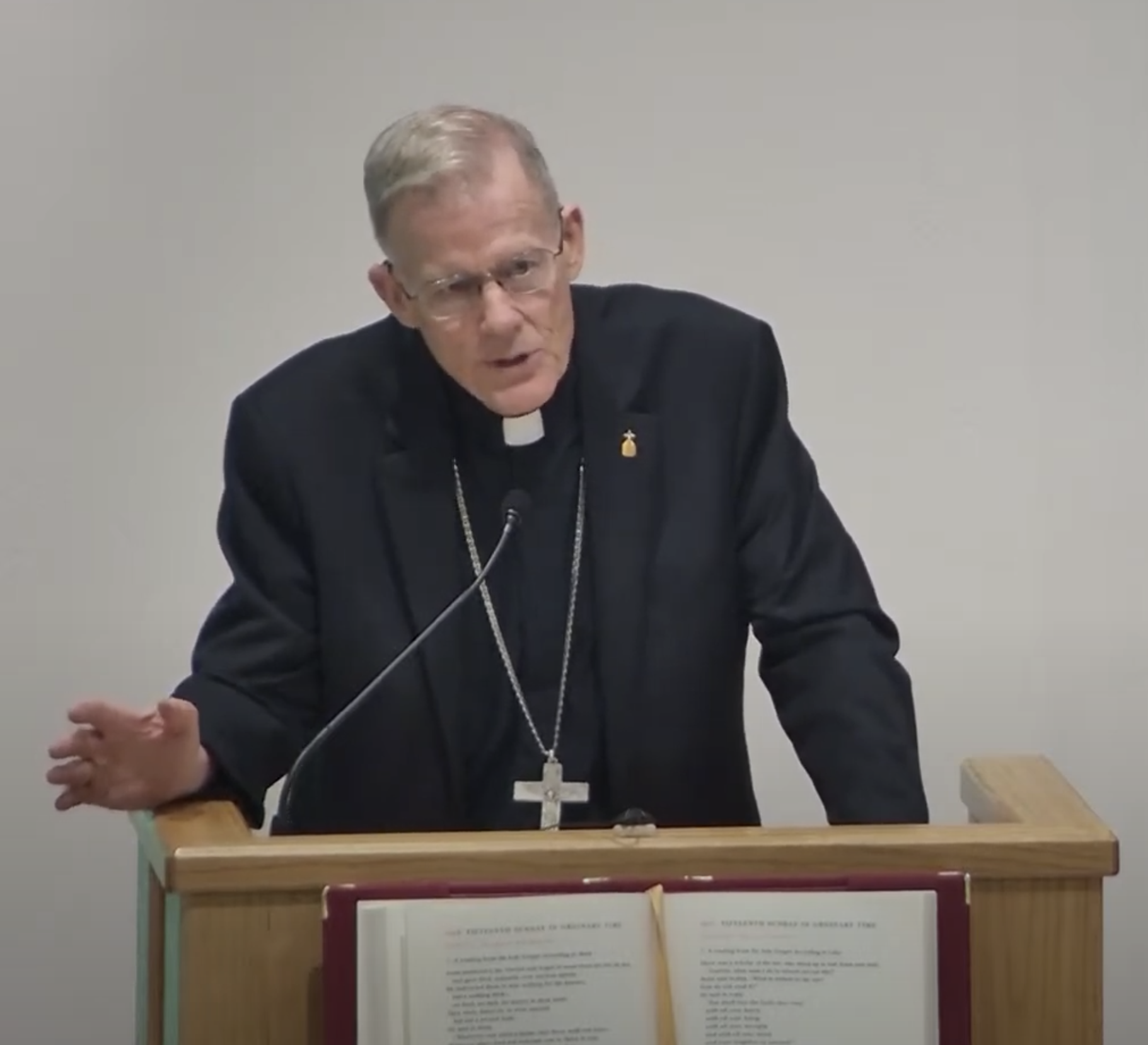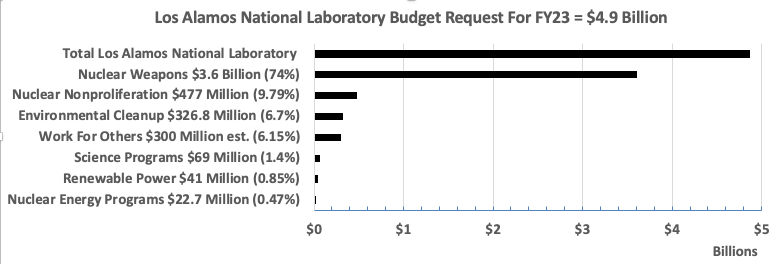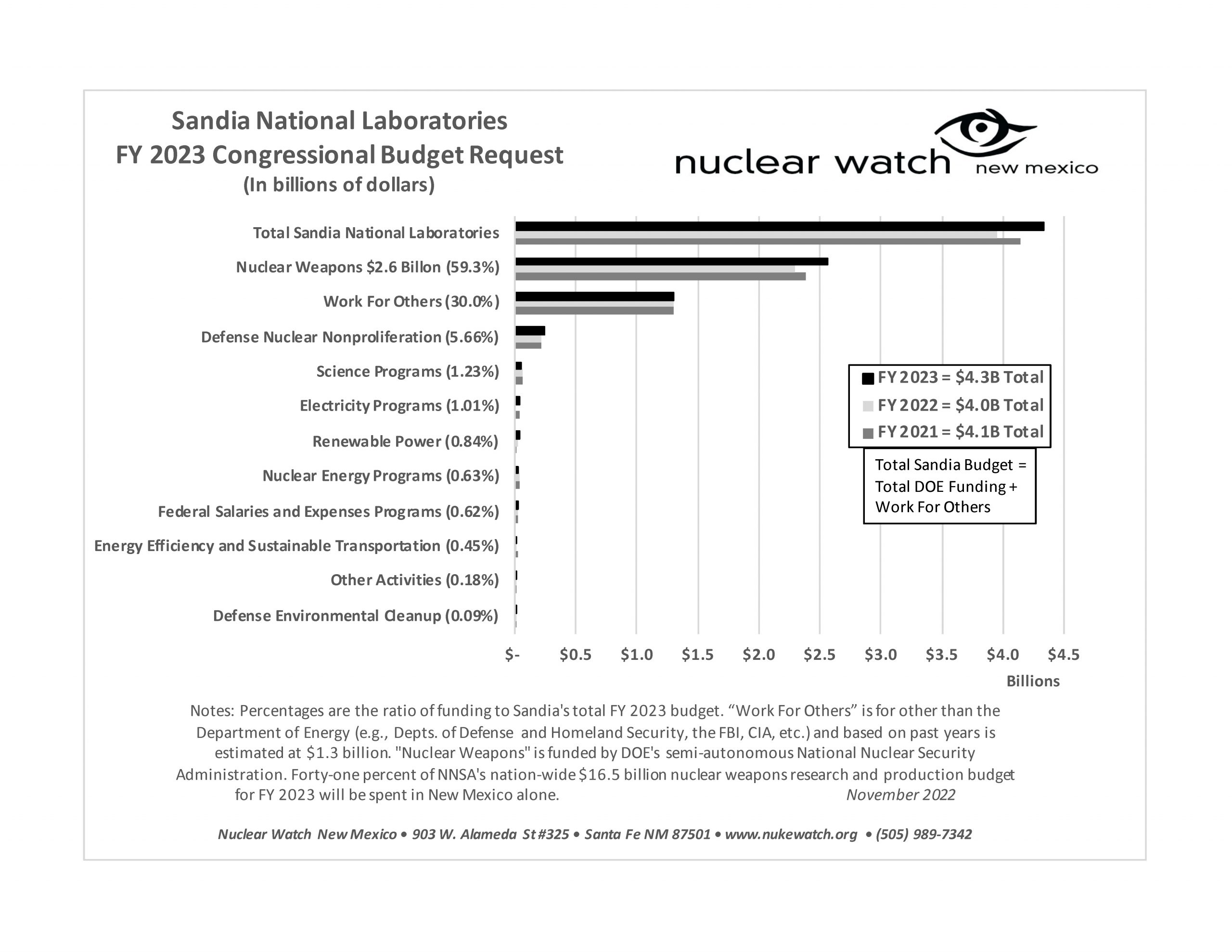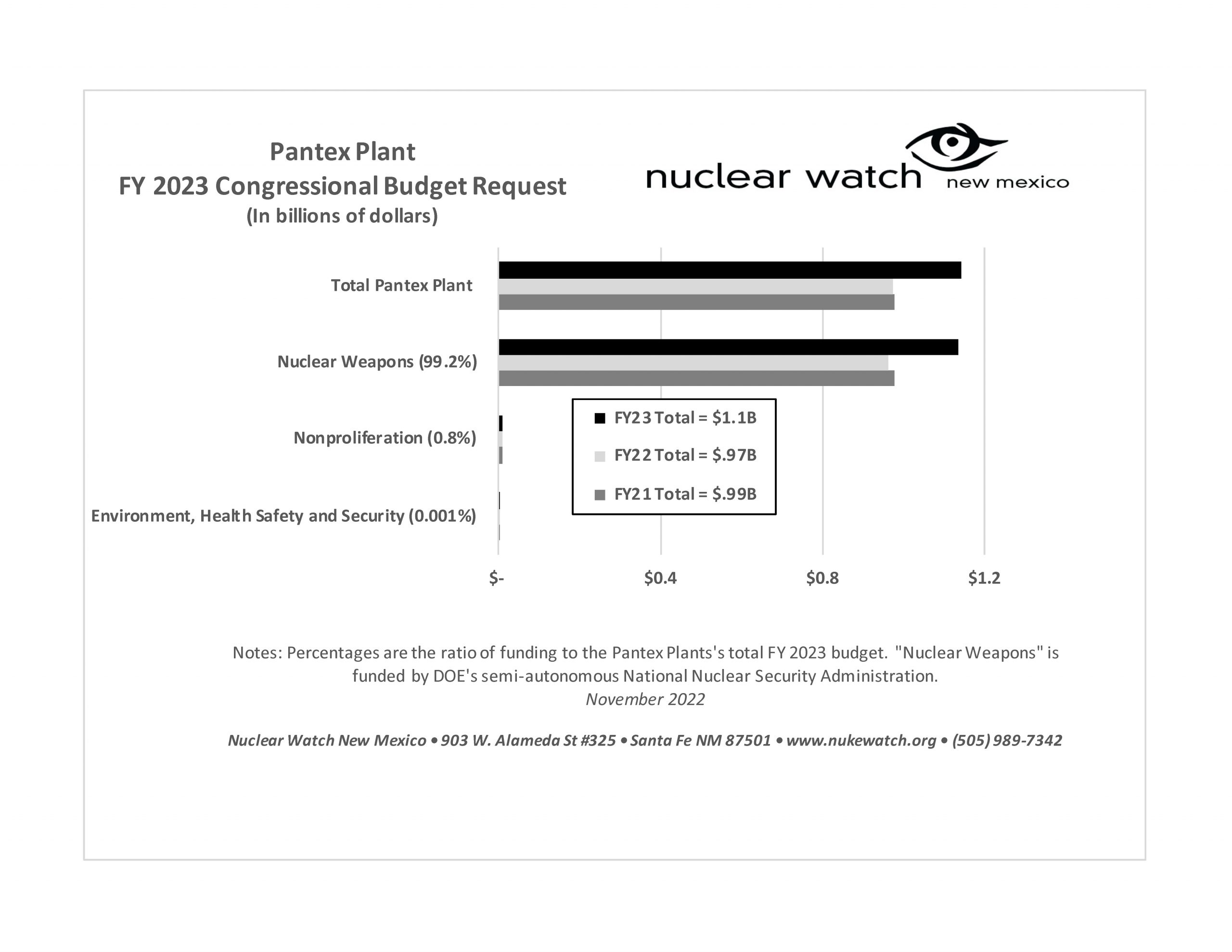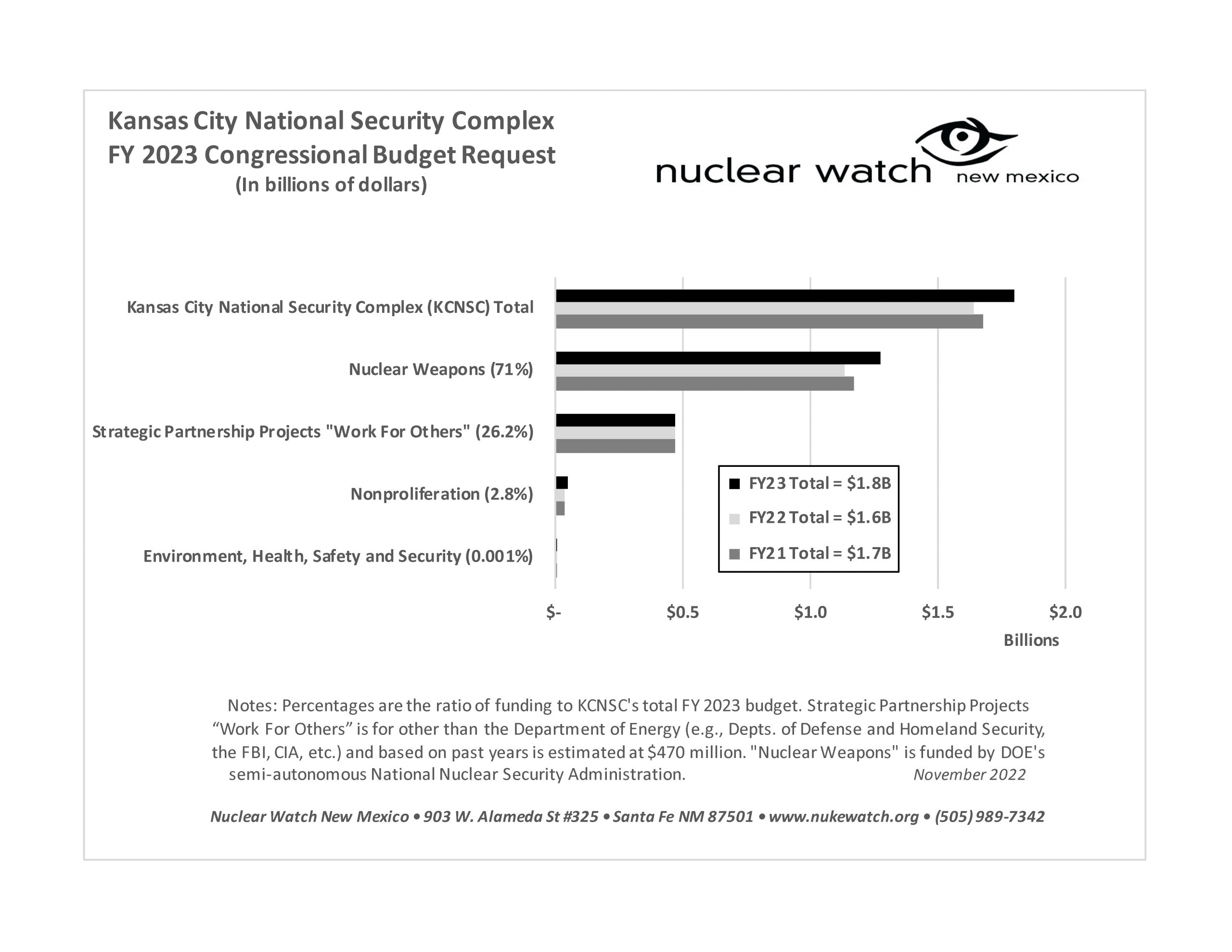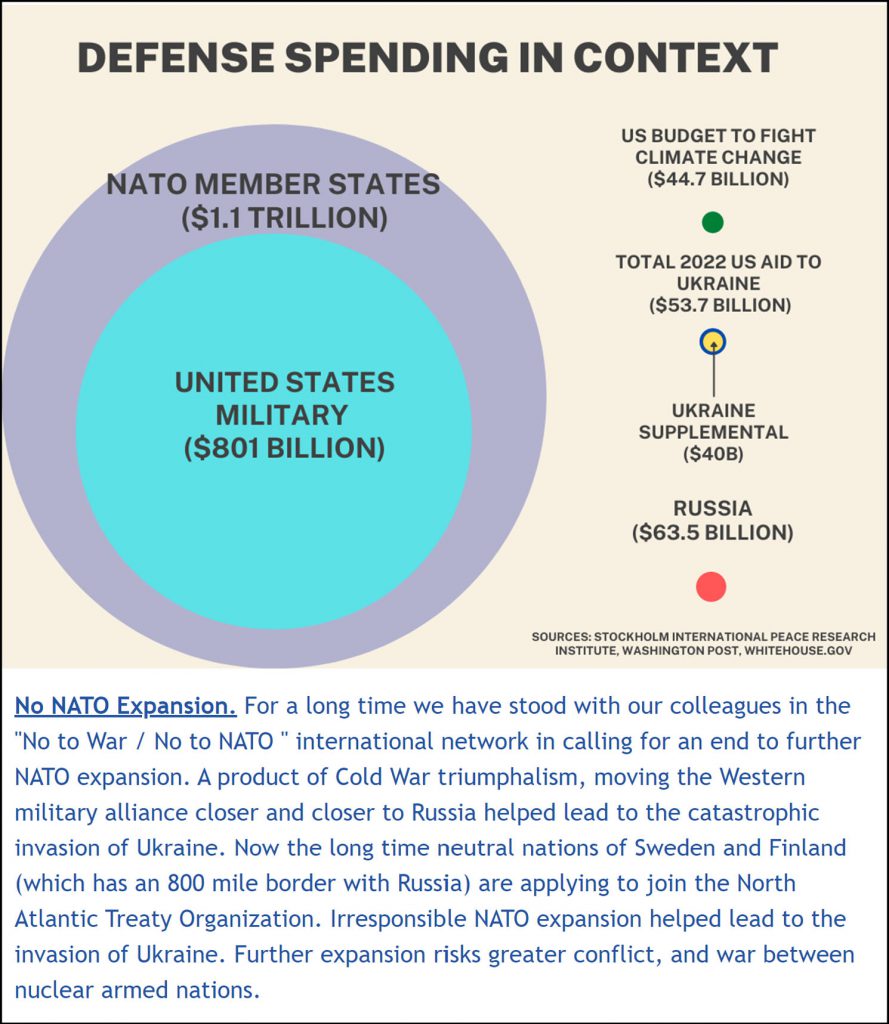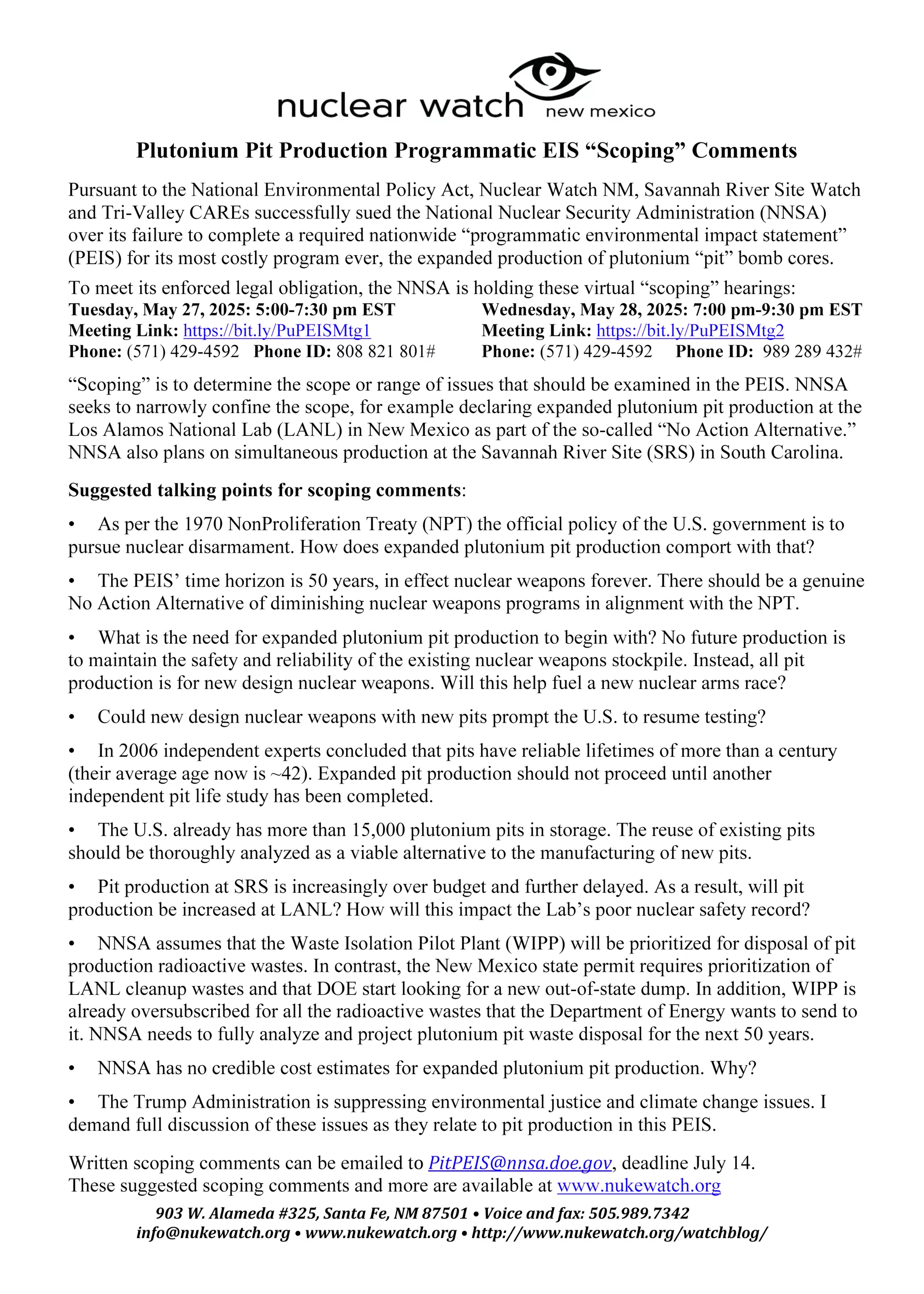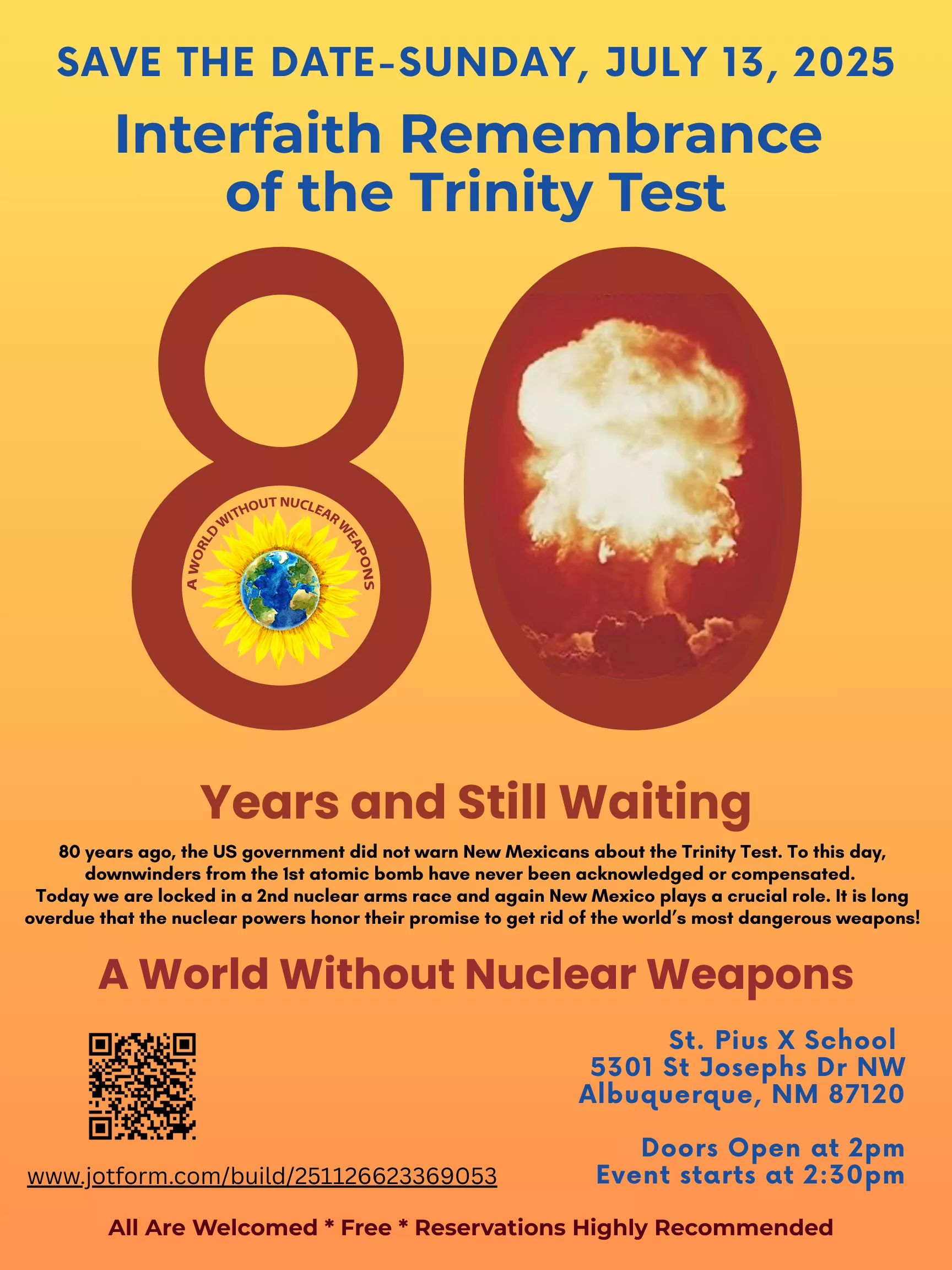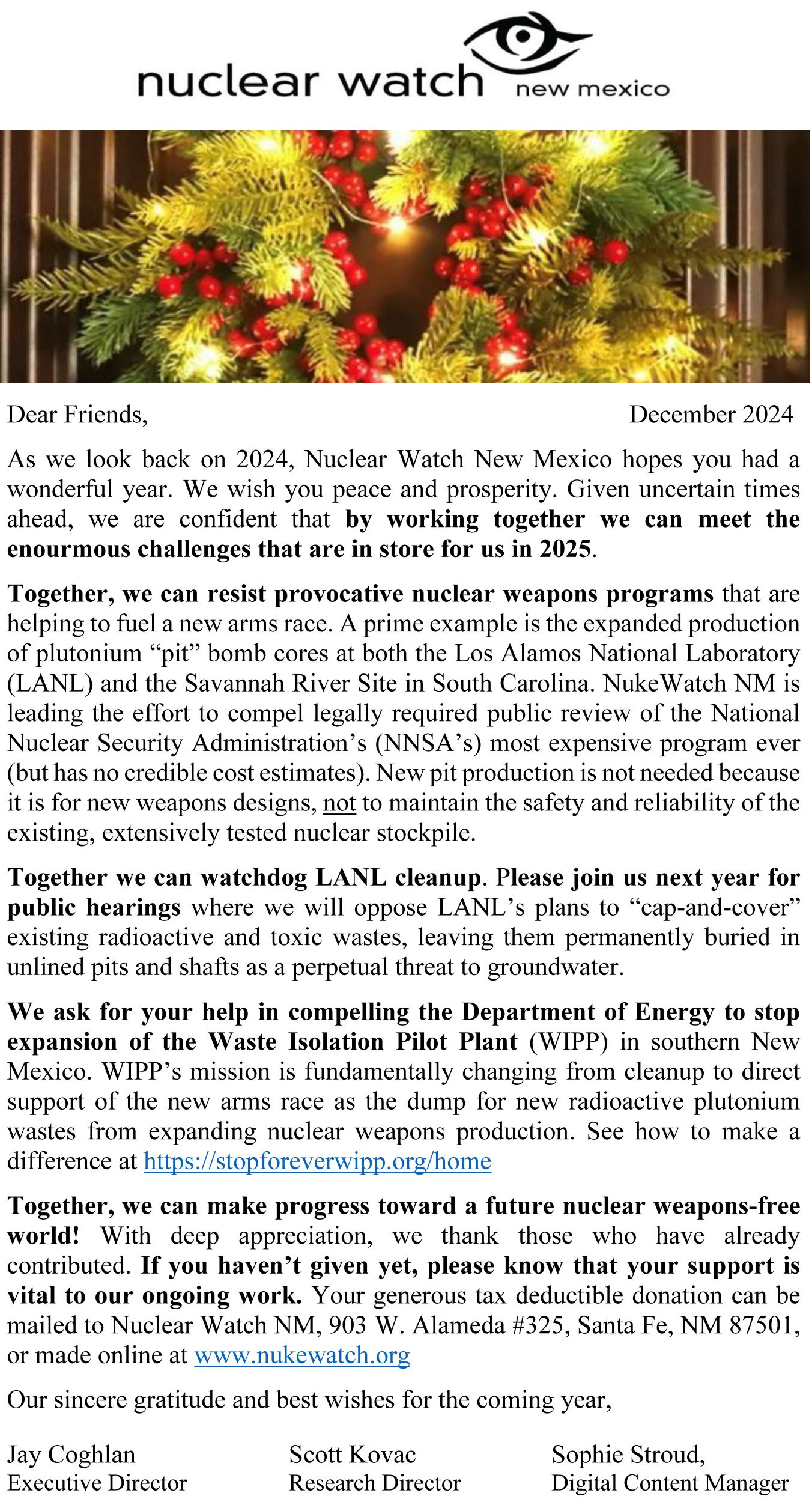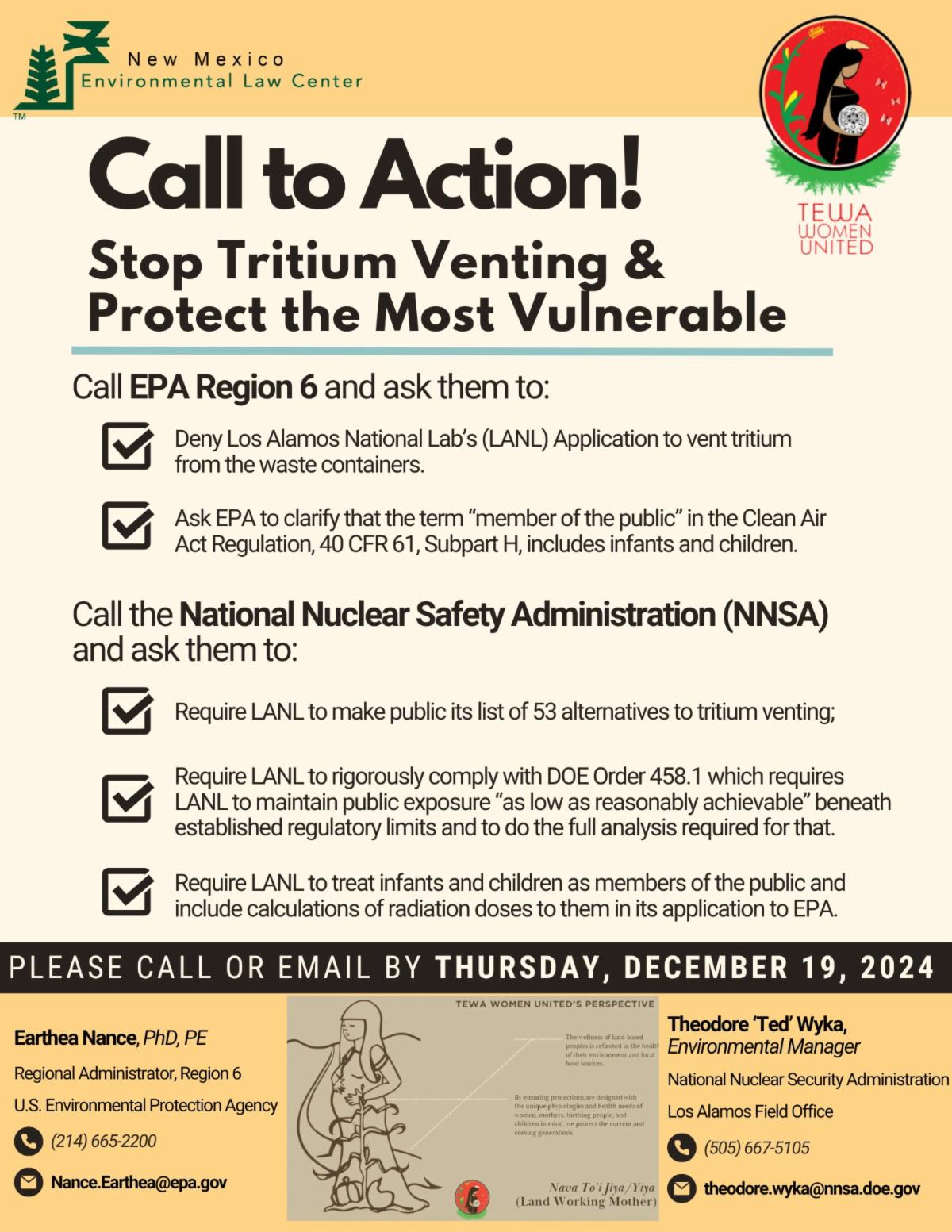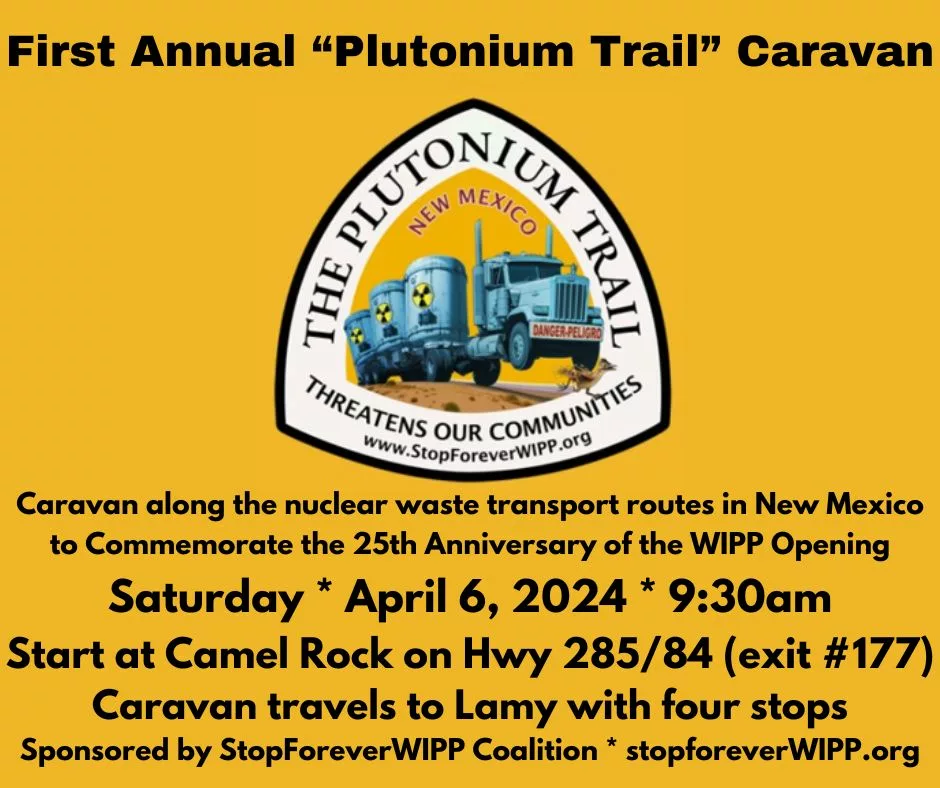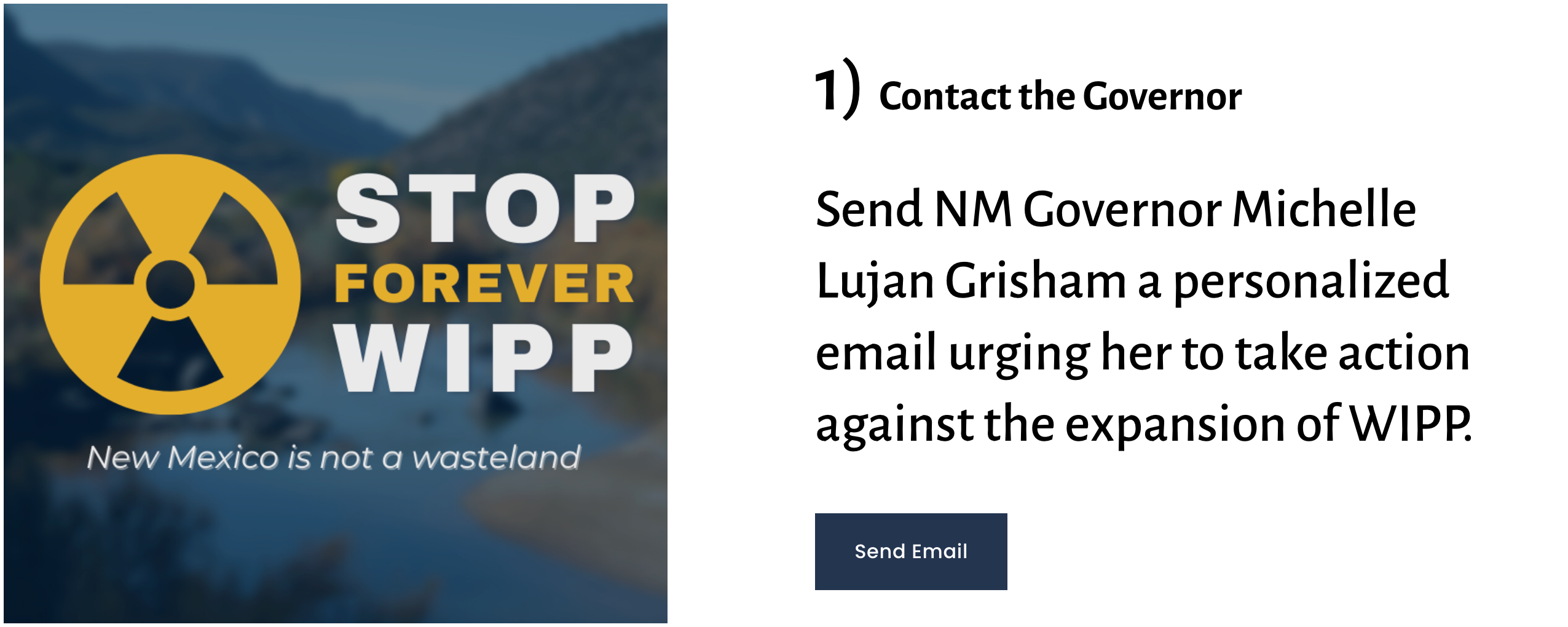QUOTE OF THE WEEK
The Trinity and nuclear bombs have nothing to do with each other
“Oppenheimer called it the Trinity Test [based] on John Donne’s poem, with the Christian reference – but that’s got to be, in my mind, the ultimate oxymoron. The Trinity and nuclear bombs have nothing to do with each other – the Trinity represents life and community, love and tolerance and respect for one another, and atomic weapons are the exact opposite of that.
So we’ve got to do all we can to rid ourselves of this destructive power, and that’s why people of faith are involved in this important matter.”
– Archbishop of Santa Fe, John C. Wester
LANL’s Central Mission: Los Alamos Lab officials have recently claimed that LANL has moved away from primarily nuclear weapons to “national security”, but what truly remains as the Labs central mission? Here’s the answer from one of its own documents:
LANL’s “Central Mission”- Presented at: RPI Nuclear Data 2011 Symposium for Criticality Safety and Reactor Applications (PDF) 4/27/11
Banner displaying “Nuclear Weapons Are Now Illegal” at the entrance in front of the Los Alamos National Lab to celebrate the Entry Into Force of the Nuclear Weapon Ban Treaty on January 22, 2021
“There is nothing comparable in our history to the deceit and the lying that took place as a matter of official Government policy in order to protect this industry. Nothing was going to stop them and they were willing to kill our own people.”
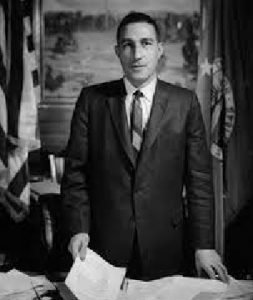
— Stewart Udall, United States Secretary of the Interior under President Kennedy and President Johnson.
He was the father of Senator Tom Udall (who ended up being a vigorous supporter of expanded nuclear weapons “modernization” plans).
Follow the Money!
Map of “Nuclear New Mexico”
Nuclear Watch Interactive Map – U.S. Nuclear Weapons Complex
In 1985, US President Ronald Reagan and and Russian President Mikhail Gorbachev declared that “a nuclear war cannot be won and must never be fought.”

Waste Lands: America’s Forgotten Nuclear Legacy
The Wall St. Journal has compiled a searchable database of contaminated sites across the US. (view)
Related WSJ report: https://www.wsj.com
2022 BLOG POSTS
Lawsuit Compels Nationwide Public Review of Plutonium Bomb Core Production
AIKEN, S.C. — Today the National Nuclear Security Administration (NNSA), the semi-autonomous nuclear weapons agency within the Department of Energy, published a formal Notice of Intent in the Federal Register to complete a nationwide “programmatic environmental impact statement” on the expanded production of plutonium “pit” bomb cores. Pits are the essential radioactive triggers of modern nuclear weapons. The NNSA is aggressively seeking their expanded production for new-design nuclear weapons for the new nuclear arms race.
The South Carolina Environmental Law Project (SCELP) successfully represented the Gullah/Geechee Sea Island Coalition and Nuclear Watch New Mexico, Savannah River Site Watch and Tri-Valley Communities Against a Radioactive Environment in a legal challenge to NNSA’s attempt to improperly jump start dual site pit production. On September 30, 2024, United States District Court Judge Mary Geiger Lewis ruled that the NNSA had violated the National Environmental Policy Act (NEPA) by failing to properly consider alternatives before proceeding with its plan to produce at least 30 pits per year at the Los Alamos National Laboratory (LANL) in New Mexico and at least 50 pits per year at the Savannah River Site (SRS) in South Carolina.
New Mexico’s Revolving Nuclear Door: Top Environment Officials Sell Out to Nuclear Weapons Labs
As part of a long, ingrained history, senior officials at the New Mexico Environment Department (NMED) have repeatedly resigned to go to work for the nuclear weapons labs, the Department of Energy, or DOE contractors. In a number of cases that is where they came from to begin with.
The hierarchy of leadership at NMED starts with the Secretary, Deputy Secretaries and then Division Directors. The position of Resource Protection Division Director is particularly critical because it oversees the two NMED bureaus most directly involved with DOE facilities in New Mexico, the Hazardous Waste Bureau and the DOE Oversight Bureau.
FULL PRESS RELEASE [PDF]
Biden’s Nuclear Posture Review Fuels the New Nuclear Arms Race
FOR IMMEDIATE RELEASE, October 27, 2022 |
Jay Coghlan, 505.989.7342 jay@nukewatch.org
Santa Fe, NM– Today, the Biden Administration has released its long awaited unclassified Nuclear Posture Review. It headlines a “Comprehensive, balanced approach to defending vital national security interests and reducing nuclear dangers.” It also declares that “deterrence alone will not reduce nuclear dangers.”
“Deterrence” against others has always been the publicly sold rationale for the United States’ nuclear weapons stockpile. First, there is the inconvenient fact that the U.S. was the first and only to use nuclear weapons in war. But secondly, the United States and the USSR (now Russia) never possessed their huge stockpiles for the sole purpose of deterrence anyway. Instead, their nuclear weapons policies have always been a hybrid of deterrence and nuclear war fighting, which threatens global annihilation to this very day.
FULL PRESS RELEASE [PDF]
The Cuban Missile Crisis 60 Years Ago, Ukraine Today: What, if Anything, Have we Learned?
/cdn.vox-cdn.com/uploads/chorus_image/image/71550878/GettyImages_515016314a.0.jpg)
By: Sophia Stroud | October 27, 2022
The 60th anniversary of the Cuban Missile Crisis this year coincides with a world again in a moment of impeding nuclear conflict with the perilous escalation of the situation in Ukraine. The Cuban Missile Crisis has been viewed as the defining confrontation of the modern age, the world’s closest brush with nuclear annihilation, until now. But “the war in Ukraine presents perils of at least equal magnitude.” The world is again on the brink of nuclear war. Russian Foreign Minister Sergey Lavrov has said bluntly “there are ‘similarities’ [of the Ukraine War] to the Cuban crisis,” mainly because Russia was now threatened by Western weapons in Ukraine. But how can we get a deeper understanding besides this surface comparison? Now seems like a good time to analyze, not what the lessons of the Cuban missile crisis are for us now, but what, if anything, have we learned from these lessons that we have supposedly have already identified by now, far past half a century later? Have these lessons really taught us anything or are “the Lessons of the Cuban Missile Crisis [Actually] Pretty Useless Right Now“?
Continue reading
New & Updated
Planned Nuclear Weapons Activities Increase to 84% of Lab’s Budget; All Other Programs Cut

The Department of Energy and Los Alamos National Laboratory have released the LANL congressional budget request for the upcoming fiscal year, 2026, which begins on October 1, 2025. The request shows a continued major increase and expansion of the plutonium pit production program (plutonium pits are the triggers of nuclear weapons). LANL is frantically trying to increase its capabilities to begin making 30 pits per year by 2028.
NukeWatch created the attached chart to give a visual of how taxpayer dollars are annually spent at the Lab. LANL’s FY 2026 total budget request is $6 billion, which is a 17% increase over the FY 2025 $5.2 billion total budget. This includes a 24% increase in the nuclear weapons budget over FY 2025.
Nuclear Weapons Activities represent 84% of LANL’s total budget.
Under the headline of “Unleashing a Golden Era of Energy Dominance and Energy Innovation and Protecting the Nation,” the nuclear weapons budget is increasing dramatically. As a baseline, 65% of the Department’s proposed $46 billion budget is earmarked for its semi-autonomous nuclear weapons agency, the National Nuclear Security Administration (NNSA). In turn, more than 80% of NNSA’s proposed FY 2026 funding is for its nuclear weapons research and production programs, with a 25% funding increase over FY 2025.
Due to so-called “reconciliation” funding, “Total Weapons Activities” increase to just under $30 billion. This adds up to a 53% increase above FY 2025 for the nuclear weapons research and production programs across the country. To help pay for this, national nonproliferation and cleanup programs are being cut by 5%, science by 14%, cybersecurity and emergency response by 25%, and energy efficiency and renewable energy programs by 74%.
THE ATOMIC BOWL: Football at Ground Zero —and Nuclear Peril Today
First prize, Best Documentary Feature, International Uranium Film Festival, Rio de Janiero
Coming to PBS in July 2025. (53-minute and 27-minute versions).
There have been numerous films on The Bomb, even one or two about Nagasaki, but “The Atomic Bowl: Football at Ground Zero — and Nuclear Peril Today” is unique, and with many lessons and warnings for today–as nuclear dangers proliferate and civilian casualties in wars climb even higher.
This football showdown featured college and pro stars, on January 1, 1946, and in (of all places) Nagasaki, near ground zero for the second atomic bomb, which killed over 80,000 just a few weeks earlier. The film, narrated by Peter Coyote, is not only the first full first-hand account of the game, but a provocative and disturbing story of the decision to drop a second atomic bomb just three days after Hiroshima–and the dangerous message to today’s leaders. Nearly all of the victims of the “forgotten bomb” were women and children and other civilians.
This important film, which includes rare footage and dozens of never published photographs, then offers a convincing argument about the relevance of Nagasaki today as mass civilian casualties in wars surge and nuclear dangers by all estimates grow every year.
Its writer and director Greg Mitchell has been one of the world’s leading authorities on the atomic bombings for several decades, and his recent film, “Atomic Cover-up,” won several awards, including the top prize from the Organization of American Historians and was aired via PBS. His two other recent films, “The First Attack Ads” and the award-winning “Memorial Day Massacre,” also earned PBS distribution (as well as Emmy nods), and like “The Atomic Bowl” were produced by Academy Award nominee Lyn Goldfarb.
Victory! Proposed Tritium Venting by LANL Halted for Now Due to Community Pressure
Proposed Tritium Venting by Los Alamos National Lab Postponed Indefinitely after Community Pressure
THANK YOU to the over 2,500 of you who signed our Petition to Deny LANL’s Request to Release Radioactive Tritium into the Air!
A massive thank you as well to our fellow campaigners we worked alongside on this issue, Tewa Women United and Concerned Citizens for Nuclear Safety, and of course thank you as well to NMED Secretary Kenney for listening to our community.

From Tewa Women United:
Beloved Community, we have some really good news!
Our Environmental Justice team has finally received the response from the New Mexico Environmental Department regarding the LANL/DOE/NNSA request for temporary authorization to begin venting tritium this summer. The short story: **Secretary Kenney (NMED) says that NMED will not act on the temporary authorization request** until the following criteria is met:
1. independent technical review
2. public meeting
3. tribal consultation (in addition to NMED tribal consultation)
4. compliance audit
These criteria must be met and LANL/DOE/NNSA must submit an updated request before NMED will revisit and make a decision.
NNSA’s Nuclear Weapons Programs Slated for 53% Increase
FOR IMMEDIATE RELEASE, June 3, 2025
Contact: Jay Coghlan – 505.989.7342 | Email
Santa Fe, NM – Topline budget figures for the Department of Energy (DOE) have been released under the headline of “Unleashing a Golden Era of Energy Dominance and Energy Innovation and Protecting the Nation.” But as a baseline, 65% of the Department’s proposed $46 billion budget is earmarked for its semi-autonomous nuclear weapons agency, the National Nuclear Security Administration (NNSA). In turn, more than 80% of NNSA’s proposed FY 2026 funding is for its nuclear weapons research and production programs, with a 25% funding increase over FY 2025.
But that is not all. The Trump Administration is adding another $4.8 billion from so-called “reconciliation” funding, bringing NNSA’s “Total Weapons Activities” to just under $30 billion. Taken together, this is a 53% increase above FY 2025 for NNSA’s nuclear weapons research and production programs. To help pay for this, nonproliferation and cleanup programs are being cut by 5%, science by 14%, cybersecurity and emergency response by 25%, and energy efficiency and renewable energy programs by 74%.
TELEVISION EVENT Trailer
Television Event is a documentary that follows the dramatic (and sometimes humorous) making and impact of the film The Day After. The 1983 film played a pivotal role in shifting public consciousness around nuclear weapons and, ultimately, President Reagan’s policies. It’s a reminder on the power of art and storytelling to create meaningful change.
The documentary was also reviewed in The New York Times: https://www.nytimes.com/2025/05/30/movies/the-day-after-documentary-television-event.html
More:
In 2023 a book was publishedd about the making of “The Day After”, read the review in Arms Control Today: https://www.armscontrol.org/act/2024-03/book-reviews/apocalypse-television-how-day-after-helped-end-cold-war
As well as: “‘The Day After’: The Arms Control Association’s Forgotten Role.” <https://www.armscontrol.org/act/2019-03/features/day-after-arms-control-associations-forgotten-role> It is a reminder that a few people can, with some luck and good timing, put big things into motion.
Full Recording: Second Scoping Hearing for NNSA’s Programmatic Environmental Impact Statement on Plutonium Pit Production
Operation Crossroads: “The World’s First Nuclear Disaster”
“With Trump back in office, the recurring question of the need for nuclear weapons testing has resurfaced in the national security debate. Project 2025’s directive that the US return to ‘immediate test readiness’ raises further alarm, given the primacy of that document in Trump’s circle. The general uncertainty around current U.S. nuclear posture gives added weight to the historical importance of the atmospheric and underwater nuclear weapons tests conducted on the Bikini Atoll, recounted here by one of the leading advocates for public safety in the nuclear age. —Ed.”
By Robert Alvarez | Washington Spectator, National Security | May 29, 2025, washingtonspectator.com
Beginning in the late 1970’s, I was working for the Environmental Policy Institute around the time when atomic veterans started to descend on the nation’s capital. I would arrange meetings with Congressional offices, and the offices of both the Defense Nuclear Agency and Veterans Affairs, to enable the veterans to share their experiences and seek justice for being sent in harm’s way. About 250,000 soldiers, sailors, Marines, Coast Guard men, and airmen took part in atmospheric nuclear weapons tests from 1945 to 1963.
John Smitherman and Anthony Guarisco were 17- and 18-year-old sailors, respectively, in July of 1946, when they took part in “Operation Crossroads”—the first two nuclear weapons tests following World War II. These tests were conducted on the Bikini Atoll of the Marshall Islands and codenamed “Able” and “Baker.”
As a result of this extraordinary indifference to lethal danger, some 200 U.S. Navy ships were contaminated, and ships carrying radioactive fallout subsequently sailed to home ports in California. These ports are still being cleaned up today, nearly 80 years later. Glenn Seaborg, the chairman of the Atomic Energy Commission from 1961 to 1971, described the Baker test as “the world’s first nuclear disaster.”
Anthony and John were part of the U.S. Navy’s Pacific fleet involving 40,000 service men and 2,000 civilians. They along with others swam in the heavily contaminated Bikini Lagoon. When I met them in 1980, John was suffering from lymphatic cancer and Anthony from a severe form of spinal arthritis.
In March 1983, Anthony and his wife Mary showed up at my cluttered office and ceremoniously handed me a large stack of documents. They had just visited the UCLA library in Los Angeles and found boxes of forgotten, declassified documents belonging to Dr. Stafford Warren, the chief safety officer during both the Manhattan Project and the 1946 Crossroads tests.
Full Recording: First Scoping Hearing for NNSA’s Programmatic Environmental Impact Statement on Plutonium Pit Production
NEW Report on Plutonium Pit Production from the Union of Concerned Scientists
Today, UCS is releasing a comprehensive report on plutonium pit production. It includes a technical assessment of plutonium aging, a critical look at the weapons programs that new pits are slated for, and suggestions for alternatives, including pit re-use.
The final chapter of the study is on the human and environmental impacts of pit production and is intended as a tool for local advocacy groups to deepen their own work around issues such as the programmatic environmental impact survey that has just kicked off.
Links to the report:
https://www.ucs.org/resources/plutonium-pit-production
Spanish language executive summary:
https://es.ucs.org/recursos/la-produccion-de-nucleos-de-plutonio
Plutonium Pit PEIS Scoping Hearing Presentation: Slides and Recording
Get Prepared: A coalition of advocacy groups, including Union of Concerned Scientists, Tri-Valley CAREs, and NukeWatch New Mexico recently held a training to help participants prepare effective comments.
Watch the recording here
Password: gP=&0LYZ
Plutonium Pit Production Programmatic EIS “Scoping” Comments
Nuclear Weapons Issues & The Accelerating Arms Race: May 2025
Nuclear Weapons Budget:
• Republicans are pushing for $1 trillion per year for military spending. The fiscal 2026 budget request calls for $892.6 billion in discretionary defense funding — same as FY 2025 (and a cut given inflation). But they are also seeking $119.3 billion through budget “reconciliation.”
• Congressional Budget Office “Projected Costs of U.S. Nuclear Forces, 2025 to 2034,” April 2025:
“Costs of Current Plans: If carried out, DoD’s and DOE’s plans to operate, sustain, and modernize current nuclear forces and purchase new forces would cost a total of $946 billion over the 2025–2034 period, or an average of about $95 billion a year, CBO estimates… CBO’s current estimate of costs for the 2025–2034 period is 25 percent (or $190 billion) larger than its 2023 estimate of $756 billion, which covered the 2023–2032 period.” https://www.cbo.gov/system/files/2025-04/61224-NuclearForces.pdf
Separately it was reported that the twelve new Columbia class submarines will cost $12 billion each, three times more than their projected cost in 2010 and is years behind schedule.
Nuclear Weapons Update:
Nuclear weapons and delivery systems would get an added $12.9 billion in the new reconciliation proposal. This includes $2 billion for sea-launched nuclear cruise missiles and $400 million for their warhead.
Accelerating Arms Race
• The current conflict between India and Pakistan is dangerous.
• 4-4-25 ExchangeMonitor: https://www.exchangemonitor.com/wrap-up-russias-modern-arsenal-and-nukes-in-ukraine-deputy-secretary-of-energy-hearing-rubio-japan-and-rok-in-brussels-more/
“Russia’s top commander in Ukraine Gen. Sergei Surovikin discussed using nuclear weapons to prevent Ukraine from advancing into Crimea in the fall of 2022, the New York Times said March 29. The Times cited U.S. intelligence reports…”
Lawsuit Compels Nationwide Public Review of Plutonium Bomb Core Production
FOR IMMEDIATE RELEASE, May 9, 2025
Media Contacts:
Ben Cunningham, Esquire, SCELP, 843-527-0078, ben@scelp.org
Queen Quet, Gullah/Geechee Sea Island Coalition, 843-838-1171, GullGeeCo@aol.com
Tom Clements, Savannah River Site Watch, 803-834-3084, tomclements329@cs.com
Jay Coghlan, Nuclear Watch New Mexico, 505-989-7342, jay@nukewatch.org
Scott Yundt, Tri-Valley CAREs, 925-443-7148, scott@trivalleycares.org
AIKEN, S.C. — Today the National Nuclear Security Administration (NNSA), the semi-autonomous nuclear weapons agency within the Department of Energy, published a formal Notice of Intent in the Federal Register to complete a nationwide “programmatic environmental impact statement” on the expanded production of plutonium “pit” bomb cores. Pits are the essential radioactive triggers of modern nuclear weapons. The NNSA is aggressively seeking their expanded production for new-design nuclear weapons for the new nuclear arms race.
The South Carolina Environmental Law Project (SCELP) successfully represented the Gullah/Geechee Sea Island Coalition and Nuclear Watch New Mexico, Savannah River Site Watch and Tri-Valley Communities Against a Radioactive Environment in a legal challenge to NNSA’s attempt to improperly jump start dual site pit production. On September 30, 2024, United States District Court Judge Mary Geiger Lewis ruled that the NNSA had violated the National Environmental Policy Act (NEPA) by failing to properly consider alternatives before proceeding with its plan to produce at least 30 pits per year at the Los Alamos National Laboratory (LANL) in New Mexico and at least 50 pits per year at the Savannah River Site (SRS) in South Carolina.
NNSA issues plans to assess pits environmental impact
“This programmatic environmental impact statement that we fought long and hard for empowers citizens to tell policy makers what they think about decisions being made in their name,” Jay Coghlan, from environmentalist group Nuclear Watch New Mexico, said Thursday in a press release by the plaintiffs of the case. “Let them know what you think about the $2 trillion ‘modernization’ program to keep nuclear weapons forever while domestic programs are gutted to pay for tax cuts for the rich.”
By ExchangeMonitor | May 9, 2025 exchangemonitor.com
On the heels of a federal judge’s ruling last fall, the Department of Energy’s National Nuclear Security Administration formally announced plans Friday for a detailed review of environmental impacts of planned plutonium pit production.
DOE’s semi-autonomous National Nuclear Security Administration (NNSA) announced in the Federal Register it is kicking off a programmatic environmental impact statement EIS to ensure that large-scale pit production will comply with the National Environmental Policy Act (NEPA).
According to the Federal Register notice, NNSA will hold public meetings and public hearings as part of the process.
Two online public scoping meetings are now scheduled for May 27 and May 28. The May 27 session would commence at 5 p.m. Eastern Time while the May 28 one is scheduled to start at 7 p.m. Eastern. Both can be accessed online or by phone. Details can be found in the Federal Register notice.
A federal district judge ruled last September that DOE and NNSA did not adequately analyze the environmental effects of producing the radioactive cores that trigger nuclear weapons in two different states, but declined to put the pit program, including construction of the Savannah River Plutonium Processing Facility at Aiken, S.C.’s Savannah River Site on hold as a result. In January, the federal government and the plaintiffs, consisting of environmentalists, settled the lawsuit and agreed to leave Los Alamos National Laboratory as the sole pit factory until NNSA completes a nationwide, NEPA-compliant programmatic EIS.Continue reading
ACTION ALERTS
Local Faith Communities to Host Interfaith Vigil for the 80th Anniversary of the Trinity Atomic Test, Calling for Global Nuclear Weapons Abolition
To commemorate the 80th anniversary of the first detonation of an atomic weapon on July 16, 1945 at the Trinity Test Site in southern New Mexico, the complete elimination of nuclear weapons must be prioritized. “80 Years and Still Waiting: An Interfaith Remembrance of the Trinity Test,” will be held at St. Pius X School, located in Albuquerque at 5301 St. Joseph’s Dr. NW, featuring music, speakers, exhibitions, and moments of reflection and prayer. The free public event will be held July 13, from 2:30–5 p.m. Doors open at 2 p.m. Pre-registration is encouraged. The event will also be live-streamed.
Pre-register at jotform.com/build/251126623369053, where you will also find the livestream link.
Public Hearings: Submit Comments on the Draft LANL SWEIS
- Review and submit comments on the Draft LANL SWEIS through March 11, 2025.
- Comments may be submitted via one of the following means:
- By email to: LANLSWEIS@nnsa.doe.gov; By mail to Mr. Stephen Hoffman, LANL SWEIS Document Manager, DOE/NNSA, 3747 W. Jemez Road, Los Alamos, New Mexico 87544; Verbally at one of the public hearings; In written form at one of the public hearings
-
Public hearings are scheduled for:
- February 11, 2025, at the Santa Fe Community Convention Center, Sweeney Room, 1-4 p.m. and 5-8 p.m. There will be a virtual option for these two meeting. Virtual hearing access instructions (g., website link or phone number) will be announced at least 15 days before the hearing and will be published in local newspapers, noticed to the GovDelivery mailing list, and available on the following websites: https://www.energy.gov/nnsa/nnsa-nepa-reading-roomand https://www.energy.gov/nepa/public-comment-opportunities.
- February 12, 2025, in Española at Mision y Convento, 5-8 p.m. This meeting is in-person only.
- February 13, 2025, in Los Alamos at Fuller Lodge, Pajarito Room, 5-8 p.m. In-person only.
- Comments may be submitted via one of the following means:
Briefing on Plutonium Migration at the Los Alamos National Laboratory
Who: Nuclear Watch New Mexico and chemist Dr. Michael Ketterer, Professor Emeritus of Chemistry and Biochemistry at Northern Arizona University
What: Nuclear Watch has mapped plutonium migration based on sampling data from Intellus, the Lab’s environmental sampling database. Our map graphically demonstrates widespread contamination down the Rio Grande to Cochiti Lake and vertically to deep groundwater. We believe it shows the need for comprehensive cleanup at LANL instead of proposed “cap and cover” that will leave toxic and radioactive wastes permanently buried in unlined pits and trenches.
When: 11:00 am MT Thursday April 25, 2024
Where: https://us06web.zoom.us/j/95570087953?pwd=R1hNUEIyb1BLaktDQzZQaWNEdlpoQT09
Meeting ID: 922 1214 9822 Passcode: 975887
This virtual briefing is for media and the public. Nuclear Watch and Dr. Ketterer will briefly present followed by Q&A. Media and reporters will be given preference for questions. Please feel free to forward this notice to others.
Our plutonium contamination map and background materials will be available at www.nukewatch.org by 10:00 am MT Thursday April 25.
First Annual Plutonium Trail Caravan
On Saturday, April 6, you will be able to join the First Annual Plutonium Trail Caravan! It will start at Pojoaque and end at Lamy. It will also stop in Eldorado and you are welcome to join the caravan on its way to the final stop in Lamy. There will be several stops along the way, with more details coming soon. Please save the date for 30 minutes on the afternoon of April 6. There will be fun satiric songs, banners, and plenty of people to ask questions about risks to neighborhoods on the route.
WIPP Information Exchange Dec. 13 – In Person and Virtual
The U.S. Department of Energy (DOE) Carlsbad Field Office (CBFO) and Salado Isolation Mining Contractors (SIMCO) (Permittees) will conduct a virtual WIPP Information Exchange pursuant to Permit Part 4, Section 4.2.1.5, Legacy TRU Waste Disposal Plan. This exchange will discuss information regarding the Legacy TRU Waste Disposal Plan.
Questions and comments outside the scope of the Legacy TRU Waste Disposal Plan should be directed to the WIPP Community Forum.
Wednesday, December 13, 2023, 2 p.m. – 4 p.m.
Skeen-Whitlock Building
4021 National Parks Hwy
Carlsbad, NM 88220
REGISTRATION:
In-Person Registration:
WIPP Information Exchange In-Person Registration: https://form.jotform.com/222836798629172
Virtual Registration:
WIPP Information Exchange Virtual Registration:
QUESTIONS:
For questions regarding this information exchange please contact the WIPP Information Center at infocntr@wipp.ws or by calling 1-800-336-9477.
Upholding the CTBT Regime in a Time of Adversity
Thursday, Nov. 16, 10:00-11:30 am, U.S. Eastern Time
RSVP via Zoom by November 14
As with other critical nuclear risk reduction and arms control agreements, the 1996 Comprehensive Nuclear Test Ban Treaty (CTBT) is under threat due to inattention, diplomatic inaction, and worsening relations between nuclear-armed adversaries.
Disturbingly, but not surprisingly, Russian President Vladimir Putin has signed a bill from the Russian parliament to “un-ratify” the CTBT, ostensibly to “mirror” the United States’ posture toward the treaty and somehow pressure the United States to ratify the pact.
Putin says Russia will not resume nuclear explosive testing unless the United States does, but Russian officials have accused the United States of making preparations to resume nuclear testing. U.S. officials deny any such plans. Russia, China, and the United States, however, all continue to engage in military nuclear activities at their former test sites.
THIS Friday! Public Meeting: WIPP Renewal, September 22, 5 – 7PM
WIPP Renewal Public Meeting – In Person or Online
WebEx link: nmed-oit.webex.com…
Meeting number: 2634 380 5952
Password: ESphqvid567
Join by phone
+1-415-655-0001 US Toll
Access code: 2634 380 5952
Location: IN-PERSON or ONLINE
ONLINE: WebEx: nmed-oit.webex.com…
IN-PERSON:
Larrazolo Auditorium
Harold Runnels Bldg
1190 So. St. Francis Drive
Santa Fe, NM 87505
or
Skeen-Whitlock Bldg
4021 National Parks Hwy
Carlsbad, NM 88220
Contact Pamela.Jones@state.nm.us
– ICAN Executive Director Beatrice Fihn on the release of the letter January 11, 2022
Interfaith Panel Discussion on Nuclear Disarmament - August 9
HELP US SUPPORT NEW MEXICO’S GOVERNOR IN ACTING TO STOP WIPP EXPANSION!
STOP “FOREVER WIPP!”
The Department of Energy is seeking to modify the nuclear waste permit for southeastern New Mexico’s Waste Isolation Pilot Plant. Dragging out WIPP’s operations decades past the original 20-year agreement violates the social contract made with New Mexicans. WIPP is being equipped to take the waste that will be generated from production of plutonium pits for nuclear warheads, and it was never supposed to do that. An expansion of WIPP will impact the entire country, not just residents of southeastern New Mexico.
View the videos below for more information, and, if you live in an area that may be endangered by these nuclear waste transportation risks, please consider making your own “This is My Neighborhood” video!
Background Information – Problems with Nuclear Waste
Mixed Waste Landfill Facts
New Nuclear Media
TELEVISION EVENT Trailer
Television Event is a documentary that follows the dramatic (and sometimes humorous) making and impact of the film The Day After. The 1983 film played a pivotal role in shifting public consciousness around nuclear weapons and, ultimately, President Reagan’s policies. It’s a reminder on the power of art and storytelling to create meaningful change.
The documentary was also reviewed in The New York Times: https://www.nytimes.com/2025/05/30/movies/the-day-after-documentary-television-event.html
More:
In 2023 a book was publishedd about the making of “The Day After”, read the review in Arms Control Today: https://www.armscontrol.org/act/2024-03/book-reviews/apocalypse-television-how-day-after-helped-end-cold-war
As well as: “‘The Day After’: The Arms Control Association’s Forgotten Role.” <https://www.armscontrol.org/act/2019-03/features/day-after-arms-control-associations-forgotten-role> It is a reminder that a few people can, with some luck and good timing, put big things into motion.

